BepiColombo - MPPE
Mercury Plasma Particle Experiment
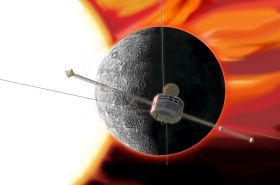 The Mercury Plasma Particle Experiment (MPPE) is a set of particle sensors which will be mounted on the Japanese Mercury Magnetospheric Orbiter (MMO). The MPPE consortium is led by the Principal Investigator Y. Saito from ISAS, Tokio, Japan.
The Mercury Plasma Particle Experiment (MPPE) is a set of particle sensors which will be mounted on the Japanese Mercury Magnetospheric Orbiter (MMO). The MPPE consortium is led by the Principal Investigator Y. Saito from ISAS, Tokio, Japan.
Science objectives
The scientific objectives of the experiment are:
-
Structure, dynamics, and physical processes of the Hermean magnetosphere
The magnetosphere will be surveyed in detail to investigate the dynamics of planetary magnetospheres in close proximity to the Sun
-
Structure, variation, and origin of Hermean exosphere
The large-scale structure and variation of the thin planetary neutral cloud will tell us more about the history of Mercury's atmosphere
-
Space environment in the inner solar system
The variations of solar wind, solar radiation and fields close to the Sun will tell us more about the structure and evolution of the heliosphere
The Instruments
ENA
(Energetic Neutral Atom)
Energetic neutral atom detector with an identified mass in the 10 eV to 3,3 keV energy range with an angular of 9x30°
|

|
HEP-e
(High Energy Particles electron)
Spectrometer producing electron energy spectra in the 30 keV to 700 keV energy range with a field of view of 20x130°
|

|
HEP-i
(High Energy Particles ion)
Spectrometer producing ion energy spectra in the 30 keV to 1,5 MeV energy range, with a field of view of 11x110° and a mass resolution of H, He, CNO, Na-Mg, K-Ca, Fe and the electrons
|

|
MEA
(Mercury Electron Analyzer)
Toroidal electrostatic analyser producing electron energy spectra in the 3 eV to 30 KeV range
|

|
MIA
(Mercury Ion Analyzer)
Toroidal electrostatic analyser producing solar wind ion energy spectra in the 100 eV/q to 30 keV/q energy range as well as Mercury's magnetosphere ions energy spectra in the 5 eV/q to 30 keV/q energy range
|
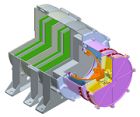
|
MSA
(Mass Spectrum Analyzer)
Toroidal electrostatic analyser + LEF-TOF mass spectrometer (Linear Electric Field - Time Of Flight) producing ion energy spectra with an identified mass in the 5 eV/q to 40 keV/q energy range, the 1 to 60 uma mass range and an angular resolution of 10 to 15°
|

|
The Location
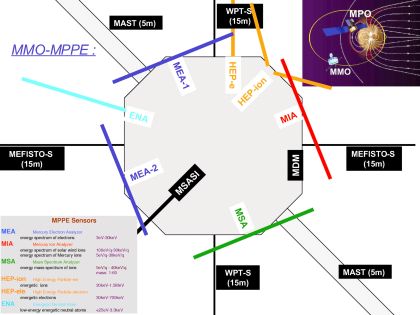 MPPE sensors mounting on MMO spacecraft
MPPE sensors mounting on MMO spacecraft
MPS contribution
The main contribution by MPS to MPPE will be scientific support for the experiment and the development of the High Voltage Power Supply for the Mass Spectrum Analyzer (MSA), part of the MPPE package. Thus we here only describe details of the MSA sensor.
The MPS contribution is supported by the German Government through the German Space Agency (DLR) under contract 50 QW 0503 and by the Max Planck Society.
The MPPE Mass Spectrum Analyzer (MSA)
The sensor design is similar to the CAPS-IMS sensor flying on the Cassini spacecraft. The scientific objective of the MSA sensor is the measurement of 3-D distribution functions for low-energy ions with both solar wind and planetary origins as well as interstellar pick-up ions with a high mass resolution.
MSA Collaboration
The MSA sensor is a top hat ion spectrometer which will be jointly developed by teams at:
- CETP, France (sensor)
- MPS, Germany (high voltage)
- DUTH, Greece & IDA, Germany (CPU)
- ISAS, Japan (electronics and sensor)
- BIRA, Belgium (until 05/2007)
Technical Data
| Energy range |
5 eV/q ~ 40 keV/q |
| Energy Steps |
64 steps (nominal step duration: 16 ms) |
| Energy resolution ΔE/E |
~ 10 % (FWHM) |
| Mass resolution m/Δm |
40 for ion energies < 15 keV/q
15 for ion energies > 15 keV/q
|
| Field of View |
8 deg. x 360 deg. (nominal) |
| Angular resolution |
8 deg. x 11.25 deg |
| Time Resolution |
2 seconds (half a spin period) for 3-D distribution function |
| Geometry factor |
10-4 cm2 sr /keV (nominal)
10-5 cm2 sr /keV (for solar wind ions)
|
Outer Sensor Structure
|
Inner Sensor Structure
|
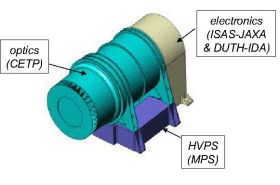
|
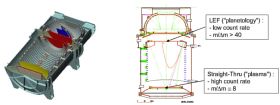
|
Measurement principle
Ions enter the sensor at the top side through a planar disc with an opening angle of 8deg. An electric field applied to two toroidal shells then selects ions of a specific energy. After energy selection ions enter a time-of-flight (TOF) unit by exciting a start signal when passing through a thin carbon foil and a stop signal when hitting a solid state detector. Between carbon foil and solid state detector a high voltage electric field is applied. Depending on their charge after passing the carbon foil will hit two different detector planes. The principle of the sensor is further explained in D.T. Young et al, Cassini Plasma Spectrometer Investigation, SpaceSciRev, 114, 1-112, 2004.
MSA Team at MPS
| Norbert Krupp | Co-Investigator |
| Joachim Woch | Co-Investigator |
| Markus Fraenz | Co-Investigator |
| Henning Fischer | Electronics Engineer |
| Alexander Loose | Electronics Engineer |
| Ulrich Bührke | Technician |
Related links
